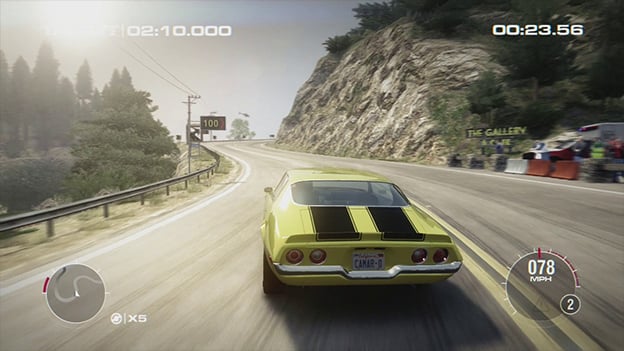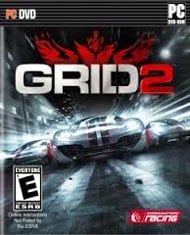The GRID Comes Alive
GRID 2 is Codemasters’ newest racing spectacle; it’s the five-year-long-awaited sequel to Race Driver: GRID, or just GRID in the United States. GRID is known for its incredible attention to detail, accessible yet realistic mechanics, enjoyable tracks, and well-done environments. GRID 2 gives us more of the same, but also makes some possibly controversial design choices with its graphics, tracks, and car selection. GRID 2 feels like a sequel to the original GRID, but it may be different enough to surprise some fans of its predecessor, and may even turn some of them off. Still, GRID 2 is a game that will attract far more new players to the franchise than it will lose old ones.
GRID 2 actually has a story to tell, which is always shaky ground for the racing genre. Past racing titles have tried to spin us tales about highway bandits trying to retake the road from underneath the government’s eyes, or hardcore street racers that don’t play by the law. GRID 2 is far tamer than that. Here, you’ll play the poster boy for a brand new racing league, World Series Racing (WSR). Your goal is simple, to raise WSR awareness and get yourself recognized as a serious competitor in a serious sport.
Yes, GRID 2’s single-player mode essentially tells a tale of marketing but it really works, feeling far more like a sports title like Madden or FIFA than the adventure title or RPG a lot of racing games, such as Burnout, try to be. Instead of rewarding you with unrealistic prizes, like loot or stolen cars, the game rewards you with fans. You aren’t thrown over-the-top parades or featured in a major motion picture; you are talked about on forums and have videos about you posted on YouTube. What’s interesting is that the cutscenes that show this social media success are really quite enjoyable, perhaps because they feel realistic. The game excels at fulfilling the fantasy of being a racing success without ruining the experience by getting too silly. Get popular enough and you’ll even have real ESPN anchors do a story about you. That will make any sports fan feel like they are having their fifteen minutes of fame.
Of course, to get this notoriety you have to race, and that means starting small and working your way up to the big leagues. There’s no shortage of racing events for you to participate in, ranging from elimination matches to checkpoint races and everything in between. You can either finish events one by one, slowly working your way up the totem pole without missing a single lap, or you can simply push forward into later game events while skipping previous ones. Either way feels great and neither destroys the game’s sense of pacing.

GRID 2 has 14 international locales to race in, with about 6 routes in each area. The game goes a long way to make these locations feel diverse. Racing in one area during a low-level event may have you skidding along back roads during an overcast day, while racing in the same area in a higher-level event will send you through nighttime streets with crowds of people watching on the sidelines and fireworks going off in the background. At points, the different events can feel familiar as you take the same series of turns you have experienced five times before in another racing mode, but it only ever amounts to a minor annoyance; a short break from the game will get you out and racing again in no time.
GRID 2 also introduces a new type of track called a Live Route that is an interesting innovation in the racing genre. Essentially, it places you in a locale, but then randomizes the turns you have to make through that locale, making it impossible to plan for upcoming curves. While Live Routes are interesting and keep locales feeling fresh, they are also frustrating; racing through them is kind of a crapshoot. You’ll eventually realize that racing games are heavily based on track memorization and planning ahead for each turn. Without the ability to play this way, you’ll mostly crash a lot and be taken by surprise by sharp turns coming up at the last minute.

GRID 2’s racing engine adds a bit to this frustration. It’s certainly not a game for racers who like to put their foot down on the accelerator like a lead weight. Its physics engine is unforgiving, asking you to slow down and lead every single turn. Crashes are horrendous, essentially costing you events at the slightest touch of another car. It’s not quite as complicated as more hardcore racing simulators out there, but this isn’t a newbie-friendly game, not by a long shot.
GRID 2 has about fifty cars to choose from in a variety of different makes and models. In the single-player mode, cars are given out easily for beating certain events. Simply progress through the campaign and soon your garage will be full of them. Even the events meant to specifically unlock a new car in your garage are simple qualifiers that never give you a lot of challenge. You’ll feel like a millionaire with the ride selection you’ll eventually end up with.
Multiplayer, however, is another story. The two modes are completely separate, meaning you can’t bring your single-player cars into multiplayer races. Instead, you’ll have to race online in order to level up and earn cash. Unfortunately, this is a horrendous grind, with cash merely trickling in. It takes multiple races to increase in level. You’ll unlock cars very slowly in multiplayer, which is frustrating because you will have already experienced them in the single-player mode. If anything, this is kind of a multiplayer deterrent, which is a shame because online racing is pretty fun. It’s just too much work to grind your way up to the car you really wanted to be racing with in the first place, especially since you have to buy your paint job and car graphics. That’s just needless padding.

There’s one thing that GRID fans probably want me to talk about, and that’s the lack of a cockpit view during races. Yes, this view is entirely absent from GRID 2, and fans of it will probably be upset. Honestly, the dashboard/hood view works just as well if this is your viewpoint of choice, but it lacks the same level of immersion that the hands-on-steering-wheel view provides. In addition, car damage looks pretty bad up close. While the cars themselves look like beautiful recreations of the real thing, a damaged hood or tire looks like a faulty model from a PS2 era racing game. Once again, it’s a minor annoyance, not enough to make you stop playing the game, but it’s worth noting.
All bells and whistles aside, GRID 2 is a pretty fun game. It delivers on the promise of a solid, balanced racing experience. Though the tracks get repetitive, the multiplayer is a grind, and you’ll be forced to race with an in-front-of or behind-your-car viewpoint, these flaws are insignificant compared to the huge payout that is GRID 2’s campaign. It’s easily one of the better racing games to come out this generation, and if you are a racing fan, you shouldn’t pass this one up.
RATING OUT OF 5 RATING DESCRIPTION 4.3 Graphics
Aside from some questionable damage graphics, GRID 2 looks awesome. 4.0 Control
Though not newbie friendly, the game still feels like a real-man’s racer. 3.8 Music / Sound FX / Voice Acting
The revving engines, skidding tires, and creaking metal in crashes sound great. 4.0 Play Value
While multiplayer is a grind, single-player is amazing. 4.1 Overall Rating – Great
Not an average. See Rating legend below for a final score breakdown.
| Review Rating Legend | |||
|---|---|---|---|
| 0.1 – 1.9 = Avoid | 2.5 – 2.9 = Average | 3.5 – 3.9 = Good | 4.5 – 4.9 = Must Buy |
| 2.0 – 2.4 = Poor | 3.0 – 3.4 = Fair | 4.0 – 4.4 = Great | 5.0 = The Best |
Game Features:
